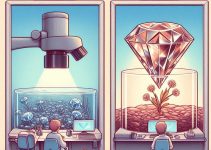It seems you are convinced that your next purchase is going to be a lab-grown diamond, and that’s because it’s budget-friendly and eco-friendly too. Well, no doubt you have literally made some thoughtful choices about your purchase. But you better have detailed plans before you actually spend your money on the lab-grown diamonds. It’s better that you review what lab-grown diamonds really offer you, along with the things that you might have missed considering before.
So, here we are with 7 things to know before you buy a lab-grown diamond.
There are many things that you can consider while buying a lab-grown diamond. However, we list here seven of the most important things you must not miss about man-made diamonds before adding them to your collection.
Carat
The carat of the lab-grown diamond or even a natural diamond is a must-know factor before buying diamonds. Carat is the unit in which diamonds are measured. Each carat of a diamond is equal to 200 milligrams. Again, they can be further seen as equaling 100 points. Some of the smaller diamonds may weigh in points too.
You must look for the carats of the diamond while buying the gemstone, and they must not be mistaken for the size of the diamond.
Color
Now, the color of the diamond is another thing to be taken into account before you buy lab-grown diamonds. The question that might come to mind is whether diamonds have colors. Well, yes, they do have colors that may range from yellow to brown. In fact, some of the diamonds are colorless too.
Gemologists arrange the diamonds or list them on a color scale that ranges from D to Z. D-E-F are the colorless diamonds. G-H are nearly colorless, and I-J are called the nearly colorless but slightly tinted diamonds. K-M are the faint yellow diamonds, and N-R are the very light yellow diamonds. S-Z are finally the light yellow.
The best diamond to find among them is the one that’s colorless. Remember, colorless diamonds are more expensive than other diamonds.
Clarity
The next thing to look for before buying a lab-grown diamond is its clarity. Due to being formed under intense pressure and temperature, lab-grown diamonds too have blemishes and inclusions in them like natural diamonds, and hence the clarity of the diamond must be known.
By clarity of the diamond, it means the number, type, and position of the flaws in the diamond. On the scale that measures the clarity of the diamond, the range starts from Loupe Clean (LC) to Piqué 3 (P3). Hence, you must pick the diamond with the best clarity.
Cut
The last of the 4Cs of a diamond is the cut of the diamond. If you are going to buy a lab-grown diamond, then the cut of the diamond is yet another thing you must look for before making your purchase. Which cut you like the most is an important thing you must finalize. There are plenty of cuts of diamonds available to choose from.
Lab-grown diamonds are as real as natural diamonds.
Since lab-grown diamonds have quite a few differences in comparison to natural diamonds and are grown in labs and not in natural environments, the thing that you need to know before buying lab-grown diamonds is that they are as real as natural diamonds.
In fact, physically, chemically, and optically, both lab-grown diamonds and natural diamonds are the same. The only difference is that they are formed in labs within weeks.
Cost-effective
One of the most important things when buying something as expensive as a diamond is definitely the budget. On one side, we have natural diamonds that cost beyond many people’s budgets. Lab-grown diamonds have changed the scenario now.
Ever since lab-grown diamonds came into existence, their cheaper price than natural diamonds has wooed many customers. As you can see, these lab-grown diamonds cost 30 to 40% less than natural diamonds. Hence, this is one of the most important things you need to know before buying lab-grown diamonds.
Longevity
We all know that lab-grown diamonds are also called man-made diamonds. The question often comes to mind: can they last forever like natural diamonds? Well, as we said earlier, lab-grown diamonds are considered as real as natural diamonds, and hence they last as long as their natural counterparts.
So, if you think your lab-grown diamond may fade over time or lose its shine, then it’s not so. The lab-grown diamonds are supposed to stay as bright till the end as they are when new.
Takeover
Needless to say, lab-grown diamonds’ each and every characteristic is an important thing to notice and review before one buys them. Over the years, these diamonds have not just provided diamond buyers with budget-friendly gemstones but also durability and sustainability.
Gen Z and millennials have been fond of lab-grown diamonds, and as such, even experts believe the demand for lab-grown diamonds is likely to grow in the upcoming years.


